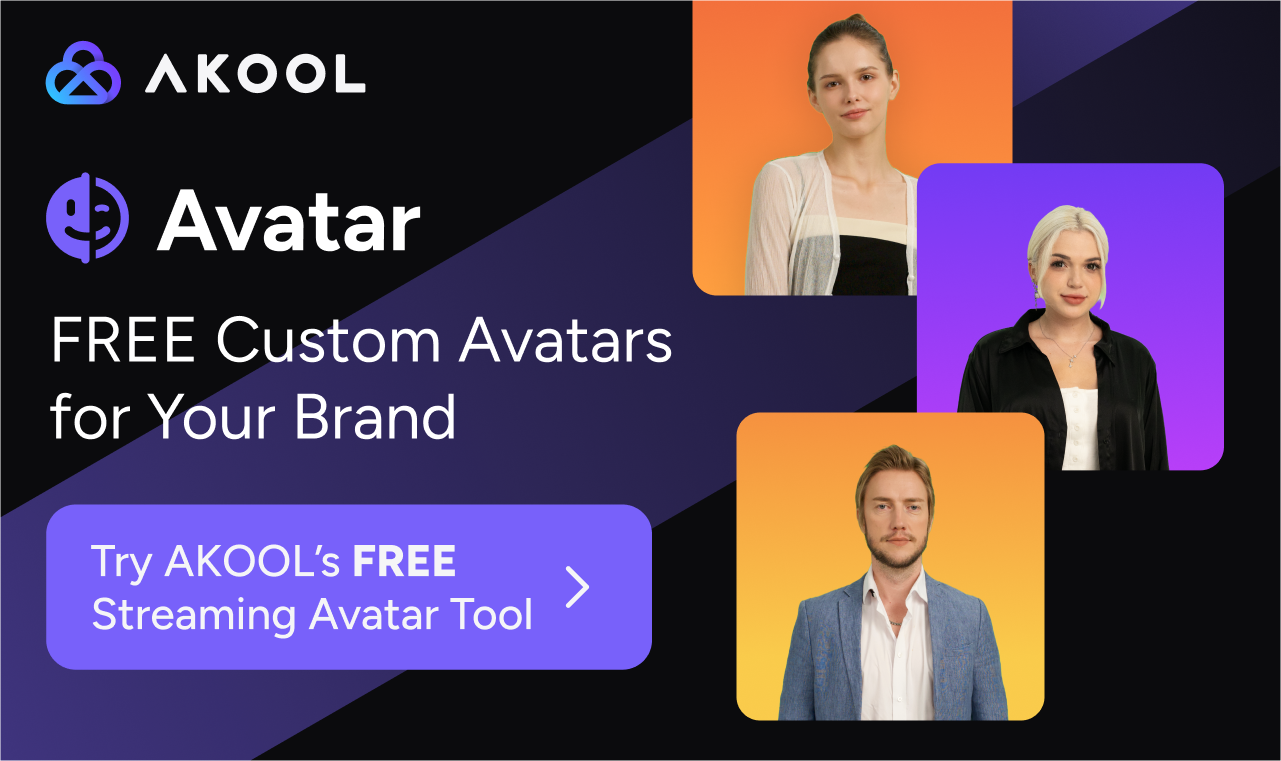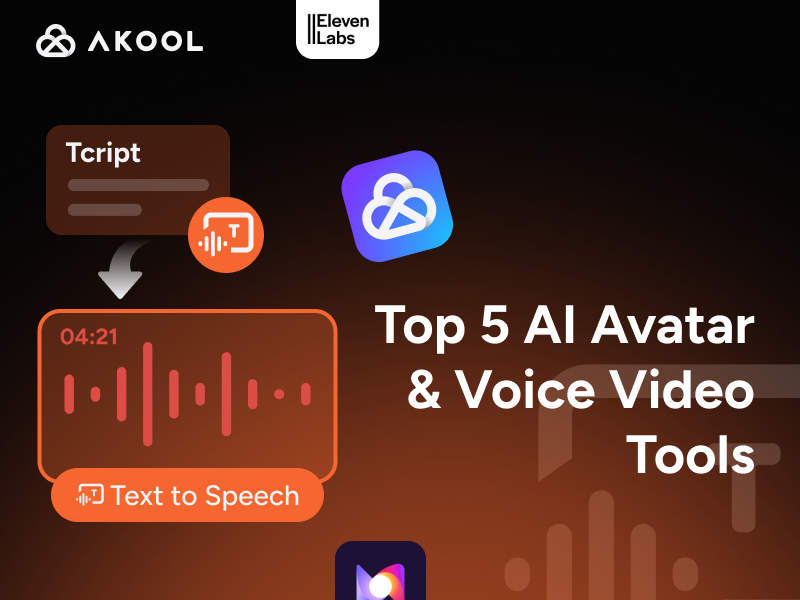AI avatar and voice video tools are transforming the landscape of video production for businesses, enterprises, and creators. By leveraging artificial intelligence, these platforms enable users to generate lifelike avatars, automate voiceovers, and streamline editing—making professional-quality videos accessible without the need for advanced technical expertise. Whether you’re producing training modules, marketing assets, or social media content, the right AI video tool can save time, reduce costs, and scale your video strategy. Below, we compare the top AI avatar and voice video tools, highlighting their features, pricing, strengths, and best-fit scenarios to help you make an informed choice.
Akool: Best for Hyper-Realistic, Branded AI Video Creation
Akool is a next-generation AI video platform designed for businesses and creators who demand hyper-realistic avatars and expressive, natural-sounding voiceovers. Explore how Akool excels among the top AI avatar platforms for video creation to deliver brand-consistent visuals that engage audiences. Its intuitive interface allows users to quickly customize avatars, select languages, and build video scenes, making it especially valuable for organizations seeking scalable, branded content for marketing, training, or social media.
Recent product updates in 2025 include expanded multi-language avatar support, improved lip-sync accuracy for more lifelike presentations, and deeper integrations with popular marketing and learning management systems (LMS). These enhancements position Akool as a top choice for enterprises looking to automate video creation while maintaining brand integrity and global reach.
Akool’s script-to-video automation stands out, but you can also compare its capabilities with other solutions in our overview of talking avatar tools. Its workflow is built for speed and consistency, enabling teams to produce polished, on-brand videos in minutes—without the need for video production expertise.
Key Features:
- Hyper-realistic AI avatars: Diverse library plus custom avatar creation for maximum engagement.
- Natural AI voice synthesis: Supports multiple languages and accents with convincing expressiveness.
- Script-to-video automation: From text input to finished video in a few clicks.
Pricing:
- Free trial available
- Paid plans start at $29/month for 10 video exports
- Custom enterprise pricing for high-volume needs
- All plans include watermark-free exports and commercial usage rights
Pros and Cons:
- Pros: Highly customizable, fast workflow, multi-language support
- Cons: Limited generative scene creation, advanced features on higher tiers

Synthesia: Best for Lifelike Digital Avatars and Multi-Language Training
Synthesia is a leading AI video creation platform known for its highly realistic digital avatars and robust multi-language capabilities. For organizations evaluating key competitors in AI video generation, our analysis of Synthesia and its main rivals offers detailed comparisons. Designed for ease of use, Synthesia allows users to generate videos by simply inputting a script—no cameras, actors, or editing skills required.
In 2025, Synthesia achieved ISO 42001 AI video certification, expanded its avatar library to over 125 options, and enhanced multi-language support. These updates reinforce its position as a market leader for professional, scalable video production in business and education.
Key Features:
- Lifelike AI avatars: Over 125 diverse avatars for inclusive training and communication.
- Multi-language voiceover: Instant translations and voice generation in dozens of languages.
- Simple script-based workflow: Text in, fully produced video out in minutes.
Pricing:
- Free plan: 9 avatars and 3 minutes of video per month
- Starter plan: $18/month for 120 minutes/year, access to 125+ avatars
- Higher tiers required for commercial use and longer videos
Pros and Cons:
- Pros: Best-in-class realism, easy for beginners, robust language support
- Cons: Limited background customization, free plan restrictions
HeyGen: Best for Creative Visual Editing and Faceswap Personalization
HeyGen stands out with its Canva-style visual editor and unique AI features, including faceswap technology and text-to-image generation. Content creators who want maximum creative control will appreciate how HeyGen complements insights from our brand marketing essentials for AI video tools. The drag-and-drop interface makes it easy to assemble videos, swap faces on avatars, and incorporate generated visuals or screen recordings.
Product updates in 2025 include AI faceswap and URL-to-video features, as well as improved editor usability for faster, more intuitive production. These enhancements make HeyGen a compelling choice for teams seeking creative flexibility and rapid iteration.
Key Features:
- Canva-style editor: Intuitive drag-and-drop interface for non-designers.
- AI faceswap: Personalize avatars or create branded influencer videos.
- Text-to-image and screen recording: Enrich tutorials and walkthroughs with AI-generated visuals.
Pricing:
- Free tier with watermarked exports
- Paid plans start at $29/month for increased limits
Pros and Cons:
- Pros: Creative flexibility, unique personalization, versatile use cases
- Cons: Less photorealistic avatars, variable faceswap quality
Vyond: Best for Animated Character Videos and Training Content
Vyond specializes in AI-powered animated character videos, making it ideal for education and corporate training. If you’re exploring free AI animation video generators for talking photos, Vyond’s robust timeline editor and custom avatar generator set it apart. The platform combines text-to-video automation with advanced editing controls, giving users flexibility to fine-tune scenes, audio, and animations.
In 2025, Vyond launched Vyond Go for streamlined automation and upgraded its AI avatar generator for animated characters. These updates accelerate high-quality animated content production across business and educational needs.
Key Features:
- AI-powered character animation: Convert text prompts into animated scenarios.
- Timeline editor: Precise control over scenes, audio, and motion.
- Custom animated avatars: Maintain consistent branding across training modules.
Pricing:
- Starter plan at $99/month ($58/month billed annually)
Pros and Cons:
- Pros: Animation versatility, detailed tutorials, AI automation
- Cons: Higher price, limited photorealism, preset style options
revid.ai: Best for Automated Social Media Video Repurposing
revid.ai is optimized for social media managers and high-volume creators who need rapid, trend-driven content. Its template library includes talking avatars and cinematic styles, similar to the approaches covered in our guide to free online AI tools for talking avatars. Daily automation features let brands stay on top of trends without manual editing.
2025 updates brought an expanded free AI suite and deeper TikTok integration, making it easier to produce inspiration-led videos. Whether transforming long-form webinars or podcasts, revid.ai’s repurposing tools help you maximize every asset.
Key Features:
- AI video templates: Create clips from articles, social posts, or prompts.
- Talking avatars: Consistent avatars for repeat brand messaging.
- Content repurposing: Turn long-form assets into shareable shorts.
Pricing:
- Free suite available
- Hobby plan at $39/month for full feature access
Pros and Cons:
- Pros: Rapid template workflows, multi-input support, high publishing frequency
- Cons: Variable output consistency, limited realism, best for social media
Feature Comparison and Market Context
Across the AI avatar and voice video tool landscape, several trends and differentiators emerge:
• Avatar Realism: Akool and Synthesia lead in photorealistic avatars and voice quality, while HeyGen offers creative faceswap, Vyond focuses on animation, and revid.ai emphasizes speed.
• Customization & Branding: Akool tops for custom avatars and deep integrations, Synthesia provides a large library, HeyGen delivers personalization tools, and Vyond’s custom animated avatars shine.
• أتمتة سير العمل: تتفوق revid.ai و HeyGen في النشر عالي التردد، وتقوم Akool و Synthesia بتبسيط تحويل النص إلى فيديو، ويقوم Vyond بأتمتة المحتوى المتحرك.
• اللغة وإمكانية الوصول: تدعم Akool و Synthesia اللغات العالمية؛ توفر Vyond و revid.ai إمكانية الوصول القائمة على القوالب؛ تتطور ميزات لغة HeyGen.
• التسعير وقابلية التوسع: توازن Synthesia و Akool بين القدرة على تحمل التكاليف وقابلية التوسع في المؤسسة؛ تلبي HeyGen و revid.ai احتياجات الفرق الصغيرة ذات النماذج المجانية؛ يعكس سعر الدخول المرتفع لـ Vyond تركيزها على الرسوم المتحركة.
عند اختيار الصورة الرمزية للذكاء الاصطناعي وأداة الفيديو الصوتي، قم بمواءمة نقاط القوة في المنصة - سواء كانت الواقعية أو المرونة الإبداعية أو التشغيل الآلي أو الحجم - مع أهداف مؤسستك وسير العمل.
أسئلة متكررة
ما هي أدوات الصورة الرمزية للذكاء الاصطناعي وأدوات الفيديو الصوتي؟
تستخدم أدوات الصورة الرمزية والفيديو الصوتي بالذكاء الاصطناعي لإنشاء صور رمزية واقعية وأتمتة التعليقات الصوتية، مما يسهل إنشاء مقاطع فيديو بدون مهارات تقنية متقدمة أو موهبة أمام الكاميرا.
كيف تساعد هذه الأدوات الشركات على توفير الوقت والمال؟
فهي تعمل على أتمتة مهام إنتاج الفيديو مثل البرمجة النصية والتعليق الصوتي والتحرير، مما يسمح للفرق بإنشاء مقاطع فيديو احترافية بسرعة وبتكلفة أقل مقارنة بالطرق التقليدية.
هل يمكنني إنشاء مقاطع فيديو بلغات متعددة باستخدام هذه المنصات؟
نعم، تدعم معظم المنصات الرائدة التوليف الصوتي متعدد اللغات والترجمة، مما يجعل من السهل إنتاج مقاطع فيديو للجماهير العالمية.
ما هي القيود الرئيسية لأدوات الفيديو بالذكاء الاصطناعي؟
تشمل القيود الشائعة التخصيص المقيد للصورة الرمزية وعناصر التحكم المحدودة في الرسوم المتحركة وتغيرات الجودة المحتملة اعتمادًا على النظام الأساسي والخطة المحددة.
هل مقاطع الفيديو التي تم إنشاؤها بواسطة الذكاء الاصطناعي مناسبة لجميع أنواع المحتوى؟
تعمل مقاطع الفيديو التي تم إنشاؤها بواسطة الذكاء الاصطناعي بشكل جيد للتدريب والتسويق ووسائل التواصل الاجتماعي. بالنسبة للمشاريع الإبداعية أو السينمائية للغاية، قد يظل إنتاج الفيديو التقليدي هو الأفضل.







